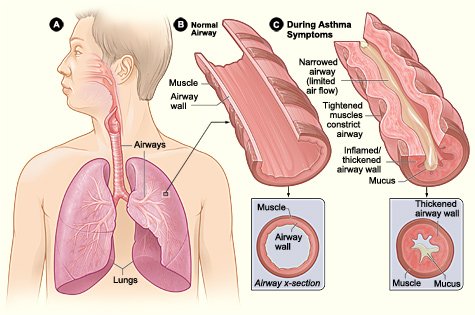Asthma is a disease that makes the
bronchial tubes more susceptible to inflammation and irritation. In other words, Asthma is a longterm respiratory condition, in which the airways may unexpectedly and suddenly narrow, often in response to an allergen, cold air, exercise, or emotional stress.

Image source
asthma affects the bronchi, not the
alveoli.
There is no way to cure it, but there are ways to treat it, so as to avoid series of attacks.
Asthma is characterised by repetitive and alterable symptoms, reversible airflow obstruction and bronchospasm.
The symptoms include; series of wheezing, shortness of breath, chest tightness, and coughing. When one is asthmatic, these symptoms may occur few times in a day, or
Few times in a week depending on the person. The condition may get worse at night or with exercise.
Asthma is caused by ecological and genetic factors but in most cases the combination of ecological and genetic factor. (NOTE: ecological factors here refers to exposure to air pollution and allergens). Other possible triggers include medications. Example of such medication includes nonsteroidal anti-inflammatory drugs (NSAIDs) ( such as ibuprofen, Motrin , Advil, naproxen, Aleve and Naprosyn ), aspirin etc. and this is due to what is known as Samter’s triad (combination of asthma, aspirin sensitivity, and nasal polyps. Nasal polyps are small growths that form inside the nasal cavity ).
Diagnosis is usually based on the type of symptoms, response to therapy over time, and
spirometry (that is, The amount of the volume of air a person can move in and out of the lungs, using a spirometer).
There is no cure for asthma and also note that The symptoms can be prevented by avoiding triggers (allergens) and by the use of inhaled corticosteroids. if asthma symptoms remain uncontrolled after some time, Long-acting beta agonists (LABA) or antileukotriene agents may also be used in addition to inhaled corticosteroids. But treatment of rapidly worsening symptoms is usually with an inhaled short- acting beta-2 agonist such as salbutamol and corticosteroids taken by mouth. In extreme cases, intravenous corticosteroids, magnesium sulfate , and hospitalization may be required.
Asthma is classified according to the rate of occurrence of symptoms, which are ;forced expiratory volume in one second and peak expiratory flow, and it could also be classified as atopic or non-atopic.
Atopic here refers to predisposition toward developing a type-1 hypersensitivity reaction.
That is, based on whether symptoms are Hastened by allergens (atopic) or not (non-atopic.
Currently, there is no clear method for classifying subgroups of asthma beyond this system, here by making Findings to identify subgroups that respond well to different types of treatments is a critical goal of asthma research.
Unlike the chronic obstructive pulmonary disease, the airway obstruction in asthma is usually reversible; however, if there a delay in treatment, the chronic inflammation from asthma can lead the lungs to become irreversibly obstructed due to airway remodeling.
symptoms can typically be improved. A specific plan for proactively monitoring and managing symptoms should be created. This plan should include the reduction of exposure to allergens, testing to assess the severity of symptoms, and the usage of medications. The treatments should be written and advise adjustments to treatment according to changes in symptoms.
The most effective treatment for asthma is identifying triggers, such as cigarette smoke , pets, aspirin and eliminating exposure to them. If trigger avoidance is insufficient, the use of medication is recommended. Pharmaceutical drugs are selected based on, among other things, the severity of illness and the frequency of symptoms. Specific medications for asthma are broadly classified into fast-acting and long-acting categories.
Bronchodilators are recommended for short-term relief of symptoms. In those with occasional attacks, no other medication is needed. If mild persistent disease is present (more than two attacks a week), low-dose inhaled corticosteroids or alternatively, an
leukotriene antagonist or a mast cell stabilizer by mouth is advised. In respect to those who have daily attacks, a higher dose of inhaled corticosteroids is used. In a moderate or severe exacerbation, corticosteroids by mouth are added to these treatments.
Image source
Salbutamol metered dose inhaler commonly used to treat asthma attacks.
Image source
Fluticasone propionate metered dose inhaler commonly used for long-term control.
For references and further research purposes on Asthma, visit the page below
See more



Congratulations @alvindavidson! You received a personal award!
You can view your badges on your Steem Board and compare to others on the Steem Ranking
Do not miss the last post from @steemitboard:
Vote for @Steemitboard as a witness to get one more award and increased upvotes!
Congratulations @alvindavidson! You have completed the following achievement on the Hive blockchain and have been rewarded with new badge(s) :
Your next target is to reach 50 replies.
You can view your badges on your board and compare yourself to others in the Ranking
If you no longer want to receive notifications, reply to this comment with the word
STOPSupport the HiveBuzz project. Vote for our proposal!